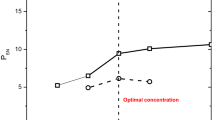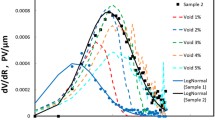Abstract
The evolution of the residual oil saturation as a function of the trapping number \(N_\mathrm{t}\) (capillary number plus Bond number), is generally known as the capillary desaturation curve (CDC) and constitutes an important input parameter in chemical enhanced oil recovery flooding. However, less importance has been paid to the investigation of the influence of oil ganglia evacuation on relative permeabilities. We report on an experimental investigation dealing with the effect of flooding parameters, fluid interfacial properties and rock structure on the CDC and on the water relative permeability. Experiments were performed on a set of water-wet sandstone plugs with different petrophysical properties, and X-ray computed tomography (CT-scan) imaging was used to accurately measure the local oil saturation. Oil ganglia size distribution as well as pore scale geometrical properties was also quantified at the scale of the micrometer using high-resolution micro-computed tomography (MCT). Results showed that the CDC depends on the pore structure and specifically on the average throat radius and the inverse of the relative permeability. Oil ganglia size distribution obtained by MCT follows a typical power law as suggested by percolation theory. We also showed that CDC obtained from macroscopic measurements can be predicted from the measured oil ganglia size distribution and rock structure geometrical parameters. In parallel, we observed that for low trapping numbers, water relative permeability is independent of the trapping number. However, for intermediate trapping numbers, a strong dependence of the water relative permeability on the latter can be noticed. In this range, we showed that water relative permeability has a specific scaling with the trapping number.















Similar content being viewed by others
References
Andrew, M., Bijelic, B., Blunt, M.J.: Pore-by-pore capillary pressure measurements using X-ray microtomography at reservoir conditions: curvature, snap-off and remobilization of residual \(\text{ CO }_{2}\). Water Resour. Res. 50, 8760–8774 (2014)
Armstrong, R.T., Georgiadis, A., Ott, H., Klemin, D., Berg, S.: Critical capillary number: desaturation studied with fast X-ray computed microtomography. Geophys. Res. Lett. 41, 55–60 (2014)
Bauer, D., Youssef, S., Han, M., Bekri, S., Rosenberg, E., Fleury, M., Vizika, O.: From computed microtomography images to resistivity index calculations of heterogeneous carbonates using a dual-porosity pore-network approach: influence of percolation on the electrical transport properties. Phys. Rev. E 84, 011133 (2011)
Chatzis, I., Morrow, N.R.: Correlation of capillary number relationships for sandstone. Soc. Pet. Eng. J. 24, 555–562 (1984)
Chatzis, I., Morrow, N.R., Lim, H.T.: Magnitude and detailed structure of residual oil saturation. Soc. Pet. Eng. J. 23, 311–326 (1983)
Datta, S.S., Ramakrishnan, T.S., Weitz, D.A.: Mobilization of a trapped non-wetting fluid from a three-dimensional porous medium. Phys. Fluids 26 (2014). doi:10.1063/1.4866641
Dullien, F.A.L., Dhawan, G.K., Gurak, N., Babjak, L.: A relationship between pore structure and residual oil saturation in tertiary surfactant floods. Soc. Pet. Eng. J. 12, 289–296 (1972)
Iglauer, S., Favretto, S., Spinelli, G., Schena, G., Blunt, M.J.: X-ray tomography measurements of power-law cluster size distributions for the nonwetting phase in sandstones. Phys. Rev. E 82 (2010). doi:10.1103/PhysRevE.82.056315
Iglauer, S., Ferno, M.A., Shearing, P., Blunt, M.J.: Comparison of residual oil cluster size distribution, morphology and saturation in oil–wet and water-wet sandstone. J. Colloid Interface Sci. 375, 187–192 (2012)
Joekar-Niasar, V., Hassanizadeh, S.M.: Analysis of fundamentals of two-phase flow in porous media using dynamic pore-network models: a review. Crit. Rev. Environ. Sci. Technol. 42, 1895–1976 (2012)
Krummel, A.T., Datta, S.S., Munster, S., Weitz, D.A.: Visualizing multiphase flow and trapped fluid configurations in a model three-dimensional porous medium. Aiche J. 59, 1022–1029 (2013)
Lorenz, C.D., Ziff, R.M.: Precise determination of the bond percolation thresholds and finite-size scaling corrections for the sc, fcc, and bcc lattices. Phys. Rev. E 57, 230–236 (1998)
Morrow, N.R.: Interplay of capillary, viscous and buoyancy forces in the mobilization of residual oil. J. Can. Pet. Technol. 18, 35–46 (1979)
Morrow, N.R., Chatzis, I., Taber, J.J.: Entrapment and mobilization of residual oil in bead packs. SPE Reserv. Eng. 3, 927–934 (1988)
Morrow, N.R., Songkran, B.: Effect of viscous and buoyancy forces on nonwetting phase trapping in porous media. In: Shah, D.O. (ed.) Surface Phenomena in Enhanced Oil Recovery, pp. 387–411. Plenum, New York (1981)
Ng, K.M., Davis, H.T., Scriven, L.E.: Visualization of blob mechanics in flow through porous media. Chem. Eng. Sci. 33, 1009–1017 (1978)
Nguyen, V.H., Sheppard, A.P., Knackstedt, M.A., Pinczewski, W.V.: The effect of displacement rate on imbibition relative permeability and residual saturation. J. Pet. Sci. Eng. 52, 54–70 (2006)
Oughanem, R., Youssef, S., Bazin, B., Maire, E., Vizika, O.: Pore-scale to core-scale aspects of capillary desaturation curves using CT-scan imaging. Paper presented at the 17th European symposium on IOR, St. Petersburg, Russia, (2013)
Payatakes, A.C., Dias, M.M.: Immiscible microdisplacement and ganglion dynamics in porous media. Rev. Chem. Eng. 2, 174 (1984)
Payatakes, A.C., Ng, K.M., Flumerfelt, R.W.: Oil ganglion dynamics during immiscible displacement—model formulation. Aiche J. 26, 430–443 (1980)
Pennell, K.D., Pope, G.A., Abriola, L.M.: Influence of viscous and buoyancy forces on the mobilization of residual tetrachloroethylene during surfactant flushing. Environ. Sci. Technol. 30, 1328–1335 (1996)
Romano, M., Chabert, M., Cuenca, A., Bodiguel, H.: Strong influence of geometrical heterogeneity on drainage in porous media. Phys. Rev. E 84, (2011). doi:10.1103/PhysRevE.84.065302
Roux, S., Herrmann, H.J.: Disorder-induced nonlinear conductivity. Europhys. Lett. 4, 1227–1231 (1987)
Shen, P., Zhu, B., Li, X.B., Wu, Y.S.: An experimental study of the influence of interfacial tension on water–oil two phase relative permeability. Trans. Porous Media. 85, 505–520 (2010)
Sinha, S., Hansen, A.: Effective rheology of immiscible two-phase flow in porous media. Epl. 99 (2012). doi:10.1209/0295-5075/99/44004
Taber, J.J.: Dynamic and static forces required to remove a discontinuous oil phase from porous media containing both oil and water. Old SPE J. 9, 3–12 (1969)
Tallakstad, K.T., Knudsen, H.A., Ramstad, T., Lovoll, G., Maloy, K.J., Toussaint, R., Flekkoy, E.G.: Steady-state two-phase flow in porous media: statistics and transport properties. Phys. Rev. Lett. 102 (2009a). doi:10.1103/PhysRevLett.102.074502
Tallakstad, K.T., Lovoll, G., Knudsen, H.A., Ramstad, T., Flekkoy, E.G., Maloy, K.J.: Steady-state, simultaneous two-phase flow in porous media: an experimental study. Phys. Rev. E 80 (2009b). doi:10.1103/PhysRevE.80.036308
Yiotis, A.G., Talon, L., Salin, D.: Blob population dynamics during immiscible two-phase flows in reconstructed porous media. Phys. Rev. E 87 (2013). doi:10.1103/PhysRevE.87.033001
Youssef, S., Rosenberg, E., Glan, N., Bekri, S., Vizika, O.: Quantitative 3D characterisation of the pore space of real rocks: improved \(\mu \)-CT resolution and pore extraction methodology. Paper presented at the International Symposium of the Society of Core Analysts, Calgary, Canada (2007)
Acknowledgments
We thank IFP Energies nouvelles for permission to publish this paper. We would like to acknowledge M.C. Lynch and E. Rosenberg for their contributions in CT and MCT scan experiments. We gratefully acknowledge F. Lamy for his technical assistance in core floods experiments.
Author information
Authors and Affiliations
Corresponding author
Rights and permissions
About this article
Cite this article
Oughanem, R., Youssef, S., Bauer, D. et al. A Multi-Scale Investigation of Pore Structure Impact on the Mobilization of Trapped Oil by Surfactant Injection. Transp Porous Med 109, 673–692 (2015). https://doi.org/10.1007/s11242-015-0542-5
Received:
Accepted:
Published:
Issue Date:
DOI: https://doi.org/10.1007/s11242-015-0542-5




